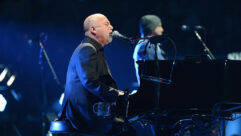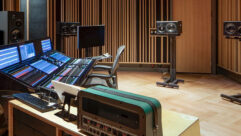On this edition of the SVC Podcast, Contributing Editor Bennett Liles talks with Ben Davis of Sound Image about their complete sound system renovation in the Arizona State University’s Neeb Hall. Ben describes the room layout and the acoustic modeling done. Then he provides details on the installation of a dual system featuring the L-Acoustics ARCS WiFo speaker array for speech and a Syva system for media sound.
Links of Interest:
· Sound Image with offices in California, Tennessee and Arizona
· The L-Acoustics ARCS Wide speaker array
· AMX Modero S Series Tabletop Touch Panel
· Biamp Systems TesiraFORTÉ DAN CI
This is the SVC Podcast from Sound & Video Contractor with Ben Davis of Sound Image. Show notes and product links for this one and the other SVC podcasts are at svconline.com. You’ll see the Podcasts link at the top of the page.
As part of a complete AV renovation of their biggest lecture hall, Arizona State University wanted better speech clarity. They brought in a team from Sound Image to take out the old sound system and modernize Neeb Hall with a unique dual sound system design and a video upgrade as well. Project Manager Ben Davis has the story on how they got all of this done, right here on the SVC Podcast.
Ben, good to have you along with us on the SVC Podcast this week, coming to us from Sound Image in Tempe, Arizona and Sound Image has some additional offices in other locations as well, right?
Yeah. Sound Image has offices in Escondido, which is our main office, San Francisco, which is a newer office we brought online, and Nashville as well as Tempe, Arizona, which is where I’m based out of. And we run touring and production out of all of those offices as well as integration. [Timestamp: 1:17]
So you’ve got a lot of touring support and AV installation. How did that whole picture evolve with the company’s history, especially on the personnel side of it?
So, I mean, what’s kind of neat about our company is kind of our background as individuals as well as a company is we’re one of the largest touring sound companies and that’s the oldest side of our company. But about 30 years ago our ownership decided that we were doing a lot of installs for artists and thought we should start an integration division, and that’s where my side of the company started. And what’s really neat about it is both sides of our company kind of work together in that a lot of us come from the production side and not only do we understand the technology and how to integrate it, but we also understand how it needs to be used. We really focus on not only building solutions, but functional solutions. We kind of look at everything holistically. Things have to sound good, look good, but they also have to be usable and have a flow to them for the user. Obviously that lends us to doing a lot of performance based type installations. And we focus a lot on performance and sports venues and things of that nature, but we also like to do things that are a little bit obscure or not mainstream. So anything that’s kind of different, whether it be multipurpose video walls or doing presentation spaces that have challenges to them, or acoustical spaces that have challenges to them. Anything that’s kind of a challenge we like to dig our hands into and see how we can come up with a good solution. [Timestamp: 3:01]
And particularly in this case you did come up with a good solution for Arizona State University in their Neeb Hall which I believe is their biggest lecture hall out of several located around the campus. With this short a time window and a fairly complex problem to solve I would guess that this was not your first project for Arizona State.
Yeah, ASU has been a great client. We have a really good relationship with them. They have had us do a few different installs for them where they’ve had speech intelligibility issues with previous systems and all of them have been a success story. So when this facility came up for a refresh in technology, they came to use to try to solve of the speech intelligibility and gain before feedback issues they’d been having in the space previously. And that’s kind of what got us started in the project. [Timestamp: 3:39]

And this room is pretty big for a lecture space but they do plenty of other things in there, too. It has sloped seating with a capacity for almost 500 so how are the acoustics in that place?
You know, they’re not terrible, but the physical structure has a lot of hard surfaces, especially on the sidewalls, that can create issues for multiple time arrivals and the psycho-acoustic side of it. So that’s kind of, when I first saw the space, kind of got me started thinking about what kind of product would give us control and make it so that I could have one point source that all the speech was coming from without exciting the room or exciting the walls too much. And that’s kind of where I started looking at L-Acoustics WiFo as the center hang. And having using it a lot in the past, I pretty much immediately visualized it in the space and I could see how it was going to be a great solution. I spent some time modeling it and that really helped me focus; how many boxes, which one I would use, the wide or the focus. Soundvision has a lot of great tools for making sure you have good even coverage, but also check your speech intelligibility with. So yeah, utilizing Soundvision I was able to make the decision that WiFo was the perfect solution for the speech side of it. [Timestamp: 5:10]
Yeah, the speech side of it with clarity from the presenters would be a central issue. But you saw this in kind of unique approach with one system for speech and the ability to switch over to a completely separate one for media presentations.
Yes. You know, we had a couple of things we had to work with in the space. One obviously was the acoustics we talked about, but the other was this was a retro existing space and they had two narrow cavities on either side of the stage that they wanted the speakers to fit into. So I was thinking about L-Acoustics for the center, and L-Acoustics had just come out with their Syva product. And it’s a narrow column array and it would fit into this cavity perfectly. So I was really interested to see if it would model out correctly and work in the space, and using Soundvision I basically placed the speakers in the cavities and turned on the modeling and it instantly – as soon as I saw the impact points starting to hit the seating venue I saw this box was almost made specifically for this venue. It worked out really well. [Timestamp: 6:15]

And those cavities on either side of the stage would have presented an immediate challenge just from ruling out a lot of things that just would not fit in there. The Syva seems made to order for that and I noticed that the columns fit right down into a recessed area on the subs that connect both the signal and the structure so you don’t have to have that cable externally.
Yeah. I mean, it’s a very clean solution. In this install everything’s hidden so it wasn’t that important that it was clean, but I could definitely see how in other spaces where this would be visible it would be a very unobtrusive product to use for a Catholic Church install or even as a portable system where it’s not being hidden by anything. It would be a very clean choice to use. It’s also very easy to integrate, because like you said we have one point of connection. We opted to do the Syva with the Syva Low so all we had to do was connect the Syva Low and energize both cabinets at the same time. So our install time was very efficient and we were able to get in and get it done and meet a pretty tight timeline. [Timestamp: 7:25]
And on the speech side, they may throw a few special things at you like an interactive class involving mics out in the audience.
Yeah, absolutely. I mean, every classroom we’ve done for them we’ve kind of standardized on (Shure) ULX-D. So we provide them with four handhelds and two body packs. So usually presenters are wearing Lavaliers and they use the handhelds to pass out into the audience and interact with them. One thing we focus on is to make sure we choose a box and deployments that makes sure we have good low-frequency control on the back end of the box so that we’re not having to do a lot of EQ and a lot of cuts in the microphone to try to keep it from feedback. We want it to be as natural as possible. We don’t want to have to have a really thin sounding microphone. We were able to do that with the WiFo and make it so the presenter could be behind the box, could be underneath the box, and have confidence that the microphones just aren’t going to take off. But then out in the audience what’s important as well is having not only even SPL coverage, but frequency response from front to back. So when we tune the microphone we’re not having to find where is the worst spot, hack the microphone to that one spot and then know that it’s going to be okay. In this venue you can pretty much EQ in one spot and know that it’s going to be the same anywhere and have really good gain before feedback, especially utilizing a 58 or a KSM8. The gain before feedback in that space is really good, especially when you have people, like you said, people out in the audience that are not professionals and don’t necessarily put the microphone where they should or speak out like they should. You need to have a lot of headroom and we definitely achieved all that with the Shure product and with the L-Acoustics product together. [Timestamp: 9:21]
Well, those were a big part and there’s a lot more to it that we’ll get into in Part 2 about how you set up the control to switch between these two separate sound systems. We’ll talk about the AMX panels the Biamp Systems Tesira DSP and a few other things. Thanks for getting with us Ben. It’s Ben Davis from Sound Image and the all new sound and video they provided for Arizona State University’s Neeb Hall. Good having you with us today, Ben.
Thanks, Bennett.
So thanks to the project team at Sound Image, ASU’s Neeb Hall is ready for anything in sound and video. Next week Ben will be back to tell us about the control aspect of the systems with Biamp Tesira DSP and AMX control panels. So we’ll get the rest of the story coming up on the next SVC Podcast.










